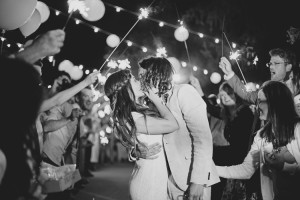
Weddings in Utah seem to follow a different set of rules from the rest of the country. Couples spend less, have shorter engagements and marry younger.
The Knot Wedding Magazine gathered responses from 13,000 brides married in 2013 and found significant regional differences. Couples in Manhattan spend an average of $86,916 (excluding the honeymoon), while Utah couples spent an average of $16,816.
Rachael Affleck, a venue management major and wedding planner in Utah for Rachael Ellen Events, requires customers to meet a minimum budget of $10,000. The company she interned for in New York City, James Abel Events, required their customers to spend a minimum of $150,000.
“Utah couples will spend the most on flowers and photography, while New York couples’ venues definitely take up the largest portion of their budget,” Affleck said.
The national average spent for venues was $13,385 in 2013.
Karla Horne, a recent BYU grad who was married in April 2014 in the Los Angeles Temple, said the venue was the most important thing besides her dress. Horne found that most venues in her area ranged from $20,000 to $30,000.
Venues chosen for receptions may include a cost for the ceremony as part of the package. Horne thought about planning a second ceremony outside of the temple so her friends and family of other faiths could be part of the ceremony.
“If I were to do one thing over again it might be to add in another ceremony so that they could be there with us,” Horne said. “If I did another ceremony it would not have added any additional cost because we would have asked our bishop to do it, and the venue that we chose for our reception was really flexible — they would have added it in for free.”
Age may play a difference between East and West Coast wedding budgets. The Knot reports that the NYC outer boroughs have the oldest brides (average age of 33.1), whereas Utah has the youngest brides on average (25.7 years). The difference in age can mean couples on the East Coast pay for their own weddings.
“In Mormon weddings, the parents almost always pay. Back East the couples usually pay because they are older,” Affleck said.
Kensie Greer, a senior majoring in nutritional science, was married in October 2014. She said her parents set her budget to match her older sister’s wedding budget; her sister had married a few years prior.
Greer described the division of costs between families. “I felt awkward about budgeting and financing between families. My mom said that if I felt uncomfortable asking his (her fiance’s) family to contribute, our family could pay for everything. His mom brought it up later and offered to pay their traditional and expected portions,” Greer said.
Martha Stewart Weddings suggests couples pay for their own wedding, especially if they have lived on their own for some time.
Aside from tying the knot younger, Utah couples are also engaged for a shorter time compared to other couples nationwide. The Knot survey reported that couples in Utah are engaged for the shortest amount of time, at 10.5 months on average. The national average length of engagement is 14 months.
Diana Pace, who formerly worked for the wedding gown company Maggie Sottero, said brides in Utah usually shop for their dresses three months prior to their wedding dates whereas brides in other states typically look six to nine months before.
“My wedding dress was the first thing I looked for and purchased while planning my wedding,” Greer said. “I think that I bought my gown three months before my wedding date.”
Pace also talked about the change in how LDS brides have selected their gowns throughout the past decade. “Most LDS brides are not wearing their dresses into the temple these days, although they are looking for garment-appropriate gowns. This has increased especially within the past five years because color has been trending, including ivory, off-white and blush,” she said.
In Utah, 88 percent of couples honeymoon after their wedding day. This stands out among other states, in which couples are less likely to take time to vacation together.
This may be a result of the dominantly LDS demographics in Utah, where couples generally do not cohabit until after marriage. The Knot reported that couples in the nation are becoming more liberal in their pre-wedding lifestyles; nearly three in four couples now opt to live together before getting married.
The results from the 2013 survey proved, “Couples aren’t marrying in religious institutions as much as they used to; just 33 percent chose to do so in 2013, down from 41 percent in 2009.”
This is another significant difference between Utah and the rest of the nation, since most LDS couples strive to be sealed in temples by a Church authority.




